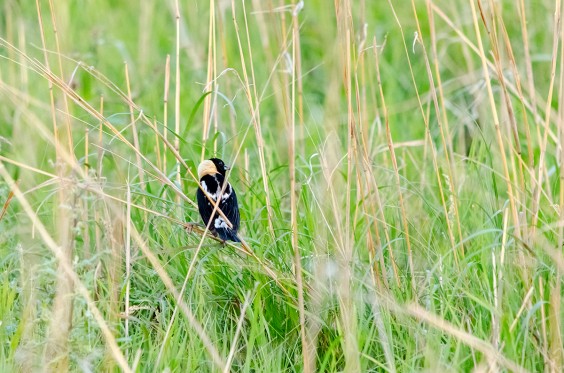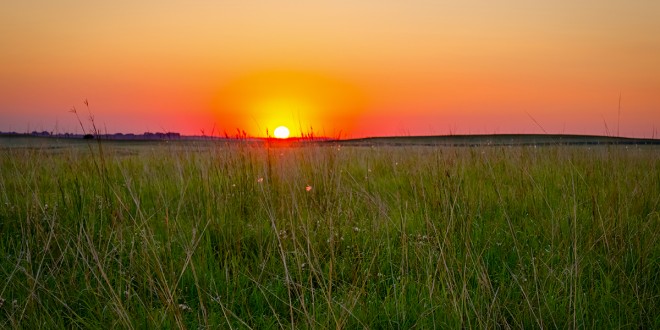Scene near Reynolds Slough in Lake County, S.D. Photo by Joshua D. Boldt
By Christopher Cumo
Armed with John Deere’s steel plow, 19th-century European settlers to America broke the prairie sod, planting corn, wheat and other small grains.
Farmers were so efficient at this work that the tall-grass prairie of what is now the Corn and Soybean Belt disappeared, according to Carter Johnson, professor of ecology at South Dakota State University. All that remains is the mixed- and shortgrass prairies of the arid west and north, and the Dakotas are one of their last great reserves.
But they may not be for long. The conversion of grassland to cropland never really stopped, and just lately the momentum has accelerated, as high crop prices and the risk reduction of crop insurance make grassland hard to leave alone.
Since 2008, the United States has lost 23 million acres of grassland and wetlands, much of it from the Great Plains, including the Dakotas. The trio of corn, soybeans and winter wheat has done the damage. Of these 23 million acres farmers have planted corn (newly adapted to tolerate drier conditions) on 8.4 million acres, soybeans on 5.6 million acres, and winter wheat on 5.2 million acres.
A recent study that looked at grassland conversion to cropland in five states (the Dakotas, Minnesota, Iowa and Nebraska) showed the most conversion happening in the Dakotas, east of the Missouri River. “Our results show that rates of grassland conversion to corn/soy (1.0–5.4 percent annually) across a significant portion of the US Western Corn Belt are comparable to deforestation rates in Brazil, Malaysia, and Indonesia,” according to study authors Christopher K. Wright and Michael C. Wimberly (“Recent land use change in the Western Corn Belt threatens grasslands and wetlands,” published Feb. 19 in the Proceedings of the National Academy of Sciences journal).
This loss of grassland is feeding into a larger trend of less livestock on the land. Several meetings have been held across South Dakota in recent months as farmers and ranchers discussed how they could keep livestock as a significant part of South Dakota agriculture.
But the grasslands also serve other purposes, according to Marissa Ahlering, a Natural Conservancy prairie ecologist. The prairies of Minnesota and the Dakotas support 40 percent of the bird species of North America, according to a Natural Conservancy publication. The grasslands also keep and build soil, filter water, and serve as big sponges during wet times to prevent flooding.
Those benefits are hard to measure against a benefit that’s measured constantly and announced several times a day: The price of Yellow No. 2 corn.
Doing What Is Profitable
The economics of modern farming, with high input and equipment costs, mean that more land being farmed by fewer farmers makes the math work out more favorably. And crop prices, even if they have come off their record highs, mean farmers are searching out cropland wherever they can find it—including in what had been pastures.
Some observers take a pragmatic approach to the loss of grasslands. They note that when crop prices are high farmers convert grasslands to crops. When crop prices are low farmers are apt to leave land in grass, perhaps renting it to ranchers. Right now, however, the momentum is on the side of high prices.
“Due to the fact that 40 percent of the U.S. corn crop is used to produce ethanol, crop prices have skyrocketed and have had the consequence of encouraging more land to be taken out of grass,” notes Ted Helms of the North Dakota State University Department of Plant Sciences.
This transition doesn’t faze Helms.“I believe that landowners have the right to do what they want with their own land,” he said.
Alan Dexter, professor emeritus at North Dakota State University, agrees.
“Farmers will do what will make them the most money in the long term,” Dexter said. “Economics drive land use in most situations where the land is privately owned.”
Woody Barth, president of the North Dakota Farmers’ Union, joins this chorus, believing that farmers and ranchers have the right to use land as they wish. He admits that recent years have witnessed a conversion of prairie to cropland. This is to be expected because the search for profits dictates land use.
Barth sees the value of this conversion because the production of lots of food keeps prices low, making consumers happy. The production of lots of food also allows the United States to export to consumers worldwide. Agriculture is the chief reason that the earth can sustain 7 billion people.
Yet as eager as he is to see farmers profit, Barth does not wish to lose all the grasslands in the Dakotas.
“We are good stewards of the land,” he said.
Farmers and ranchers will preserve grasslands for income and the enjoyment of future generations. Farmers, Barth said, appreciate the value of striking an ecological balance between grasslands and cropland.
He even sees a role for government in voluntarily enlisting farmers to the cause of grassland preservation, but he is against government mandating how farmers use land in the fulfillment of some idyllic vision. If government were to arrest the conversion of grasslands to crops, the cost would be high.
“If the USA values wildlife and natural habitat, we are going to have to pay for it,” Helms says.
Dexter has a similar mindset.
“If the government wishes to preserve an uneconomical prairie situation, then the government will need to purchase land or pay the owners an amount similar to what the landowners would earn through other more profitable land uses,” Dexter said.
Though some argue that government policy is supporting the conversion of grasslands to cropland, Scott Faber, Soren Rundquist, and Tim Male, coauthors of a 2012 report called “Plowed Under,” suggest that crop insurance is responsible for the tilling of a great deal of grassland, noting that the insurance removes the risk of planting crops on land that might otherwise have remained in grass.
Crop insurance is currently heavily subsidized by the federal government. With the expected end of direct payments, crop insurance subsidies will likely be the largest government subsidy most commodity farmers receive once the new farm bill is settled.
What’s the motivation for change?
Dexter does not see the ecological danger in this situation. He points to drilling for oil in North Dakota as far more destructive than all the conversion of grasslands to crops over the years. Farmers have actually done well in mitigating environmental problems like wind and water erosion, notes Dexter. Dust storms, once common in North Dakota in the early 1970s, are now rare.
Jim Ringelman, director of conservation programs at Ducks Unlimited, is reluctant to use an ecological argument to preserve grasslands because farmers are businesspeople who think in terms of profits not environmentalism. In a society driven by capitalism, an environmental argument may not make headway. The preservation of ranching is, he believes, the strongest argument for the retention of grasslands.
Unlike Helms, Ringelman sees a role for government in halting the loss of grasslands.
“Our elected officials should understand the economic, social, and environmental value of maintaining healthy, fertile soils,” he said.
After all, grass is what gave the Great Plains its marvelous soils, Ringelman and Johnson agree. When a grass plant dies, it, including its fibrous root system, decomposes to enrich the soil with organic matter. It is this organic matter that nourishes crops.
Johnson worries that farmers may be squandering soils that took millennia to form in the rush to make a quick profit. Moreover, the Dakota grasslands host bees and other pollinators part of each year, observes Ringelman. Without the grasslands we would have no bees and no crops that depend on insect pollination, which includes one-third of all crops, including most fruit.

Bobolinks’ numbers are declining due to a loss of habitat. They generally nest in grasslands. Photo by Joshua D. Boldt
Ripple effects from loss of grass
The value of grasslands goes beyond economics. Lisa McCauley, a postdoctoral researcher at South Dakota State University working in cooperation with the Northern Prairie Wildlife Research Center in North Dakota, notes that the demise of the grasslands affects wetlands as well, causing them to drain. In a process that she calls “consolidation drainage,” small wetlands in an area drain to form a single wetland. Whereas North Dakota once had a large number of wetlands, the number has shrunk, though each remaining wetland is larger.
Editor’s note: Landowners could affect grassland conversion
While it is true that many farmers are lobbying to convert grassland to cropland of their own accord, others are feeling pressure from the landowners they rent from to make the conversion.
The difference between grassland and cropland rent is significant: In Clark County, S.D., for example, the 2012 average rental rate for cropland was $108 an acre, while the average rental rate for pasture was $28 an acre.
When landowners, many of whom no longer live in the area, and some of whom have purchased the land as an investment, see the difference in rental rates, they may not be likely to consider much else.
But landowners have the final say in how their land is used. For those interested in preserving grassland, convincing landowners that keeping some land in grass is a wise investment of a different sort might be the most effective use of resources. —Heidi Marttila-Losure
This process has led to greater stability in the water level of wetlands, but at a cost. In the past the small wetlands dried during arid weather, leaving a niche for shorebirds. Now the remaining wetlands, retaining water year round, no longer attract shorebirds. Waterfowl also languish because the new wetlands harbor fewer aquatic invertebrates to serve as food.
According to Faber, Rundquist and Male, the loss of grasslands threatens the survival of the swift fox, the sage grouse, the prairie chicken, the whooping crane, and the mountain plover. In the Dakotas, the deterioration of wetlands that McCauley describes may cause waterfowl populations to decline nearly 40 percent.
“It would be a crime to lose all that biodiversity and historical value,” Johnson says.
Preservation strategies
One solution to this problem may lie in more, not less, government. The federal government holds grasslands in the Dakotas, notes Johnson. The Fish and Wildlife Service, a government agency, has additional grasslands. Unfortunately there is not enough money to pay all the farmers who might sell their land to keep it in grass.
By getting marginal land out of production and into grass, the government encourages farmers to crop the best land.
Faber Rundquist, and Male advocate the passage of a farm bill that would require farmers to protect grasslands and wetlands as a precondition to receiving crop insurance.
But it’s possible that there’s also a less-government solution: Some have argued for eliminating crop insurance subsidies altogether, which would put the risk of farming marginal land on the farmer. Eliminating the ethanol mandate would also have the effect of dropping crop prices, making it less appealing to convert grassland to cropland. Neither of those solutions is likely to be popular in rural communities, especially those that have seen a significant rise in incomes related to the ethanol industry.
Nonprofits may have a significant role to play. Johnson notes that the Nature Conservatory holds grasslands out of production. Ducks Unlimited, Ringelman hopes, will one day be able to offer carbon credits to farmers and businesses that preserve grasslands.
Grassland advocates may have to speak up, however. Right now, crop prices are making the most persuasive argument.
 Dakotafire Get your spark here.
Dakotafire Get your spark here.



